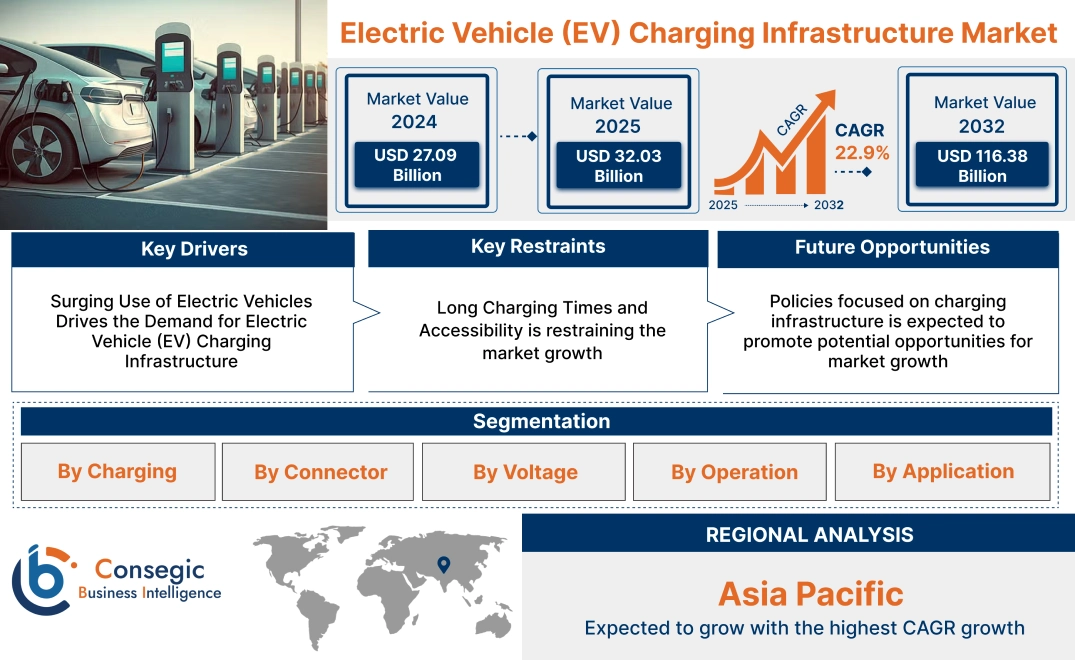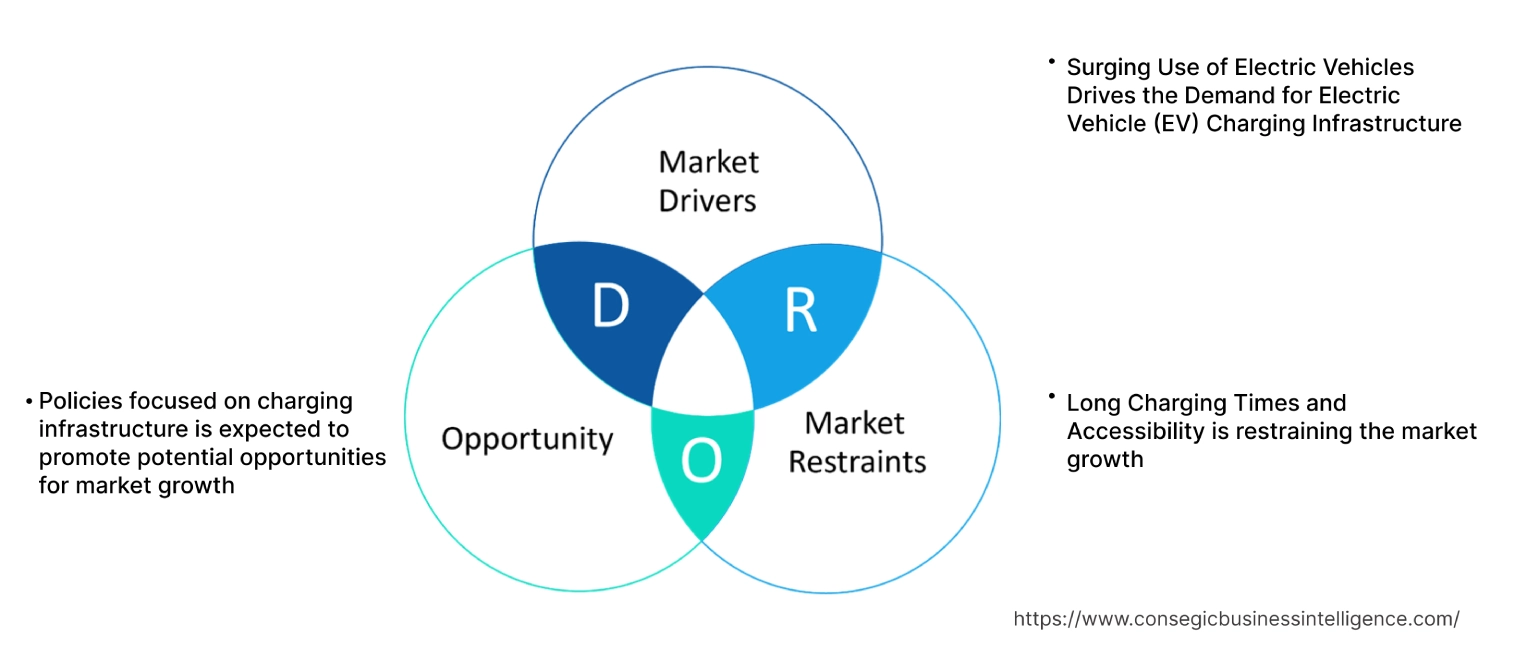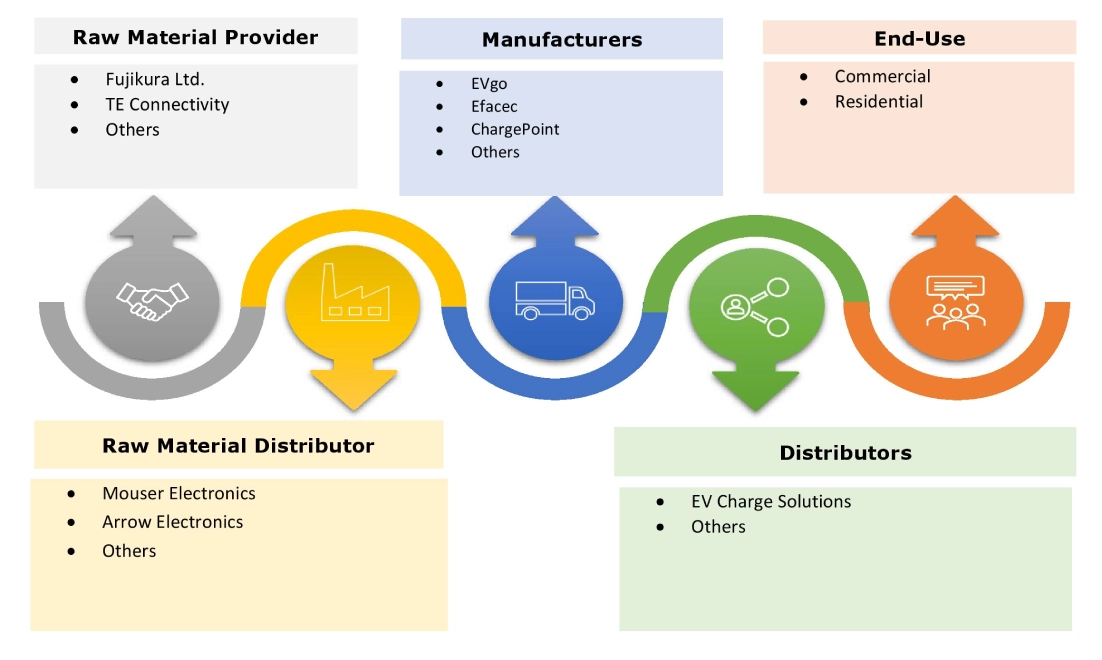- Summary
- Table Of Content
- Methodology
Electric Vehicle (EV) Charging Infrastructure Market Size:
Electric Vehicle (EV) Charging Infrastructure Market size is estimated to reach over USD 116.38 Billion by 2032 from a value of USD 27.09 Billion in 2024 and is projected to grow by USD 32.03 Billion in 2025, growing at a CAGR of 22.9% from 2025 to 2032
Electric Vehicle (EV) Charging Infrastructure Market Scope & Overview:
Electric vehicle (EV) charging infrastructure is a combination of equipment that enables the charging of electric vehicles with the help of charging stations. Also, there is availability of various voltage capacity including level 1, level 2, and level 3 & 4. Additionally, the advantages including increased convenience, cost savings, increased renewable energy adoption, and lowered carbon emissions among others are driving the electric vehicle (EV) charging infrastructure market demand. Further, the increasing focus towards sustainability is driving the adoption of electric vehicles which in turn is fueling the electric vehicle (EV) charging infrastructure market growth.
Key Drivers:
Surging Use of Electric Vehicles Drives the Demand for Electric Vehicle (EV) Charging Infrastructure
The rapid adoption of electric vehicles due to improving technology, and government support is paving the way for electric vehicle (EV) charging infrastructure market growth. Additionally, the rising fuel prices and growing environmental concerns is boosting the adoption of electric vehicles which in turn is driving the electric vehicle (EV) charging infrastructure market demand. Further, adoption of electric vehicles leads to significant improvements in air quality by reducing the dependency on gasoline and diesel-powered vehicles drives the need for electric vehicle (EV) charging infrastructure industry.
- For instance, according to IEA, the electric car sales contributed to 18% in total cars sold in the year 2023 as well as up from 14% in 2022. Additionally, Electric car sales in 2023 were 3.5 million higher than in 2022.
Therefore, the rising adoption of electric vehicles is driving the need for charging infrastructure, in turn proliferating the growth of the market.
Key Restraints:
Long Charging Times and Accessibility is restraining the market growth
The fastest DC chargers take around 30 minutes while AC charger takes several hours which is less convenient compared to traditional fuel refueling in turn hindering the electric vehicle (EV) charging infrastructure market expansion. Also, long charging time affects travel plans due to frequent and longer stops along the journey. Further, the penetration of electric vehicles charging stations is limited as well as certain areas lack the necessary infrastructure to support the installation of charging stations in turn hindering the electric vehicle (EV) charging infrastructure market expansion.
Therefore, the long charging times and accessibility are restraining the market growth.
Future Opportunities :
Policies focused on charging infrastructure is expected to promote potential opportunities for market growth
The rising government support and investment in the promotion of electric vehicles is paving the way for electric vehicle (EV) charging infrastructure market opportunities. Also, urbanization and smart city initiatives are promoting the development of electric vehicles charging infrastructure. Further, the adoption of charging stations at bus depots offers a convenient way to charge vehicles in turn driving the market evolution.
- For instance, according to IBEF, public EV charging stations nationwide reached 12,146 units as of February 2024. Additionally, the Ministry of Heavy Industries provided subsidiaries of USD 96.13 million for development of electric vehicle public charging stations.
Hence, the rising government support and investment is anticipated to increase the development of EV charging stations, in turn promoting prospect for electric vehicle (EV) charging infrastructure market opportunities during the forecast period.
Electric Vehicle (EV) Charging Infrastructure Market Segmental Analysis :
By Charging:
Based on the charging, the market is bifurcated into AC and DC.
Trends in the Charging:
- The rising adoption of AC charging at home and workplace among others due to cost-effectiveness, and battery-friendly capabilities is driving the electric vehicle (EV) charging infrastructure market trend.
- The expanding public charging points are driving the need for DC charging which in turn is propelling the electric vehicle (EV) charging infrastructure market trend.
AC charging accounted for the largest revenue share in the year 2024.
- The widespread accessibility of AC charging solutions due to availability at homes, workplaces and public areas is driving the AC charging segment progress which in turn boosts the electric vehicle (EV) charging infrastructure market size.
- Further, the increasing focus towards reliable and convenient charging solution is driving the AC charging segment which in turn fuels the electric vehicle (EV) charging infrastructure market size.
- For instance, in June 2023, ABB developed cutting-edge software for E-mobility’s range of AC charging solutions. The advantages include reliability and convenience for customizing charging sessions.
- Thus, according to the electric vehicle (EV) charging infrastructure market analysis, increasing focus towards reliable and convenient charging solutions is driving the AC charging segment.
DC charging is anticipated to register the fastest CAGR during the forecast period.
- The DC charging stations support fast charging capability driving application in highways and commercial fleet operation.
- Additionally, governments across the world are increasing investment in the development of fast charging infrastructure to support EV adoption which in turn is fueling the electric vehicle (EV) charging infrastructure market share.
- Therefore, the government support and increasing investment are anticipated to boost the DC charging segment progress during the forecast period.
By Connector:
Based on the connector, the market is segmented into CHAdeMO, CCS, and others.
Trends in the Connector:
- The trends towards smart grid integration with CCS connectors is driving market development.
- The trend towards rise of wireless charging is driving the demand for CCS connectors which in turn is fueling the market development.
CHAdeMO accounted for the largest revenue share of m41.29% in the year 2024.
- The CHAdeMO connector offers a quick charging solution and is popular at rapid charging stations.
- Also, the traditional home charging solution offers charging at a rate of 7kW whereas CHAdeMO offers ranges of 400kW in turn driving the adoption in home charging solution which in turn is boosting the electric vehicle (EV) charging infrastructure market share.
- For instance, in July 2023, VINCI Autoroutes deployed 87 electric charging stations equipped with 50kW terminals, CHAdeMO and type 2 connectors for driving ultra-fast charging solution for EV drivers.
- Thus, the ability to provide fast charging capability as compared to traditional charging solution is driving the CHAdeMO connector segment.
CCS is anticipated to register the fastest CAGR during the forecast period.
- The CCS connector offers both AC and DC charging through a single connector as well as providing fast charging capability with DC charging solution.
- Further, the key factor driving the adoption of CCS connector is the interoperability across the EV charging ecosystem which in turn is driving the segment progress.
- Furthermore, the widespread adoption of CCS connectors drives the market adoption.
- Therefore, according to the electric vehicle (EV) charging infrastructure market analysis, the interoperability across the EV charging ecosystem is anticipated to boost the adoption of CCS connectors during the forecast period.
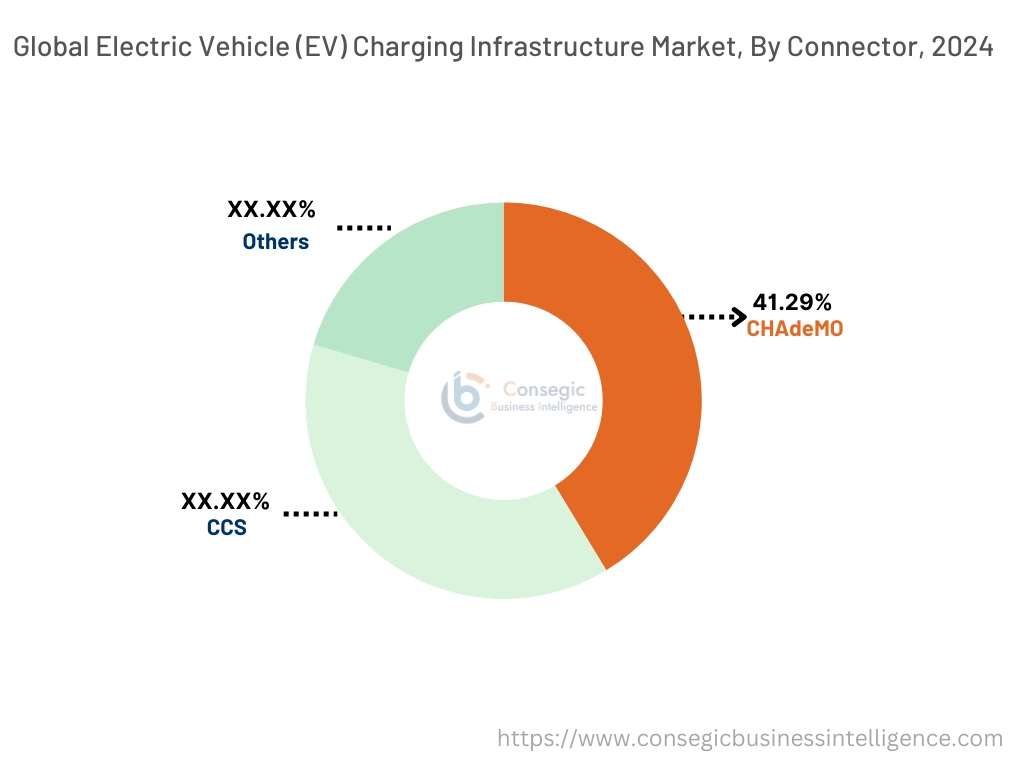
By Voltage:
Based on the voltage, the market is segmented into level 1, level 2, and level 3-5.
Trends in the Voltage:
- The trend towards rise of ultra-fast chargers is driving the demand for level 3-5 voltage chargers in the market.
- The rising need for fast charging support at home is driving the need for level 2 voltage chargers in the market.
Level 2 accounted for the largest revenue share in the year 2024.
- The level 2 voltage offers higher-rate AC charging through 240V for application in home, workplace, and public charging.
- Also, the level 2 voltage can complete BEVs 80% charging in 4-10 hours and PHEV in 1-2 hours driving the adoption in home, workplace, and other applications.
- For instance, in January 2025, Danlaw, Inc launched CleverCharge Level 2 home EV charging system offering personalized experiences for EV owners. Additionally, the system offers features such as AI assistant, mobile app dashboard displays and others.
- Thus, as per the market analysis, the ability to charge BEV and PHEV in less time is driving the adoption of level 2 voltage segment.
Level 3-5 is anticipated to register the fastest CAGR during the forecast period.
- The level 3-5 voltage segment are considered as DC fast charger which completes 80% charging in 20-40 minutes.
- Also, the level 3-5 voltage is widely used for longer-distance EV travel, which in turn drives the market demand.
- Additionally, the level 3-5 voltage offers between 50 kW and 400 kW power for charging which supports between 150 miles and 300 miles range depending on the power output.
- Therefore, as per the market analysis, the rising adoption in longer-distance EV travel is anticipated to boost the market during the forecast period.
By Operation:
Based on the operation, the market is segmented into mode 1, mode 2, mode 3 and mode 4.
Trends in the Operation:
- The rising adoption of portable charging solutions is driving the need for mode 2 operation segment.
- The rising focus towards increasing the efficiency and flexibility of EV charging is paving the way for progress of mode 4 operation.
Mode 3 accounted for the largest revenue share in the year 2024.
- The mode 3 operated EV stations are mostly found in shopping centers, homes, gas stations, and workplaces among others for providing fast charging capabilities.
- Further, the growing popularity of faster charging capability and growing infrastructure is driving the adoption of mode 3 operation.
- For instance, in November 2024, BRIGHTBLU launched JOLT Home which is an AC charger designed for 4-wheeler EVs with Mode 3 standard for charger-to-vehicle communication.
- Thus, as per the market analysis, the growing popularity of faster charging capability and infrastructure is driving the adoption of mode 3 operation.
Mode 4 is anticipated to register the fastest CAGR during the forecast period.
- The mode 4 operation is majorly found in public charging stations, highways, and others, catering to the increasing need for charging infrastructure.
- Also, the mode 4 operation offers higher power levels compared to other modes providing fast charging capability in shorter period of time.
- Further, the rise of smart charging solutions as well as adoption of plug and charge features is driving the need for mode 4 operation.
- Therefore, as per the market analysis, the ability to offer higher power levels compared to other modes is anticipated to boost the market during the forecast period.
By Applications:
Based on the applications, the market is bifurcated into commercial and residential.
Trends in the Applications:
- The integration of EV with mobile apps for easy payment solutions during recharging is driving the market development for commercial applications.
- The rising adoption of AI and automation to improve the efficiency and reliability of public charging stations is driving the commercial applications segment.
Residential accounted for the largest revenue share in the year 2024.
- The residential application consists of EV charging solution for private houses and apartments/societies is driving the adoption in residential application.
- Also, the home charging capability offers convenience and potential cost savings solutions to EV owners.
- Further, the increasing focus towards integrating EV station with renewable energy sources is driving the market adoption in residential segment.
- For instance, in January 2024, LeapCharger Corporation launched home EV charging solutions in retail market of Dubai. The increasing need for accessible and efficient charging options is driving the adoption of home EV charging solutions in Dubai.
- Thus, as per the market analysis, increasing focus towards integrating EV station with renewable energy sources is driving the adoption of market in residential segment.
Commercial is anticipated to register the fastest CAGR during the forecast period.
- The rapid adoption of commercial EV is driving the need for EV charging infrastructure in turn driving the commercial automotive industry.
- Additionally, the increasing investment by government towards development of EV charging infrastructure is driving the market evolution.
- Further, the rise in charging-as-a-service model and increasing focus towards sustainability is driving the adoption of market in commercial segment.
- Therefore, as per the market analysis, the increasing investment by government as well as rapid adoption of commercial EV are anticipated to boost the market during the forecast period.
Regional Analysis:
The regions covered are North America, Europe, Asia Pacific, the Middle East and Africa, and Latin America.
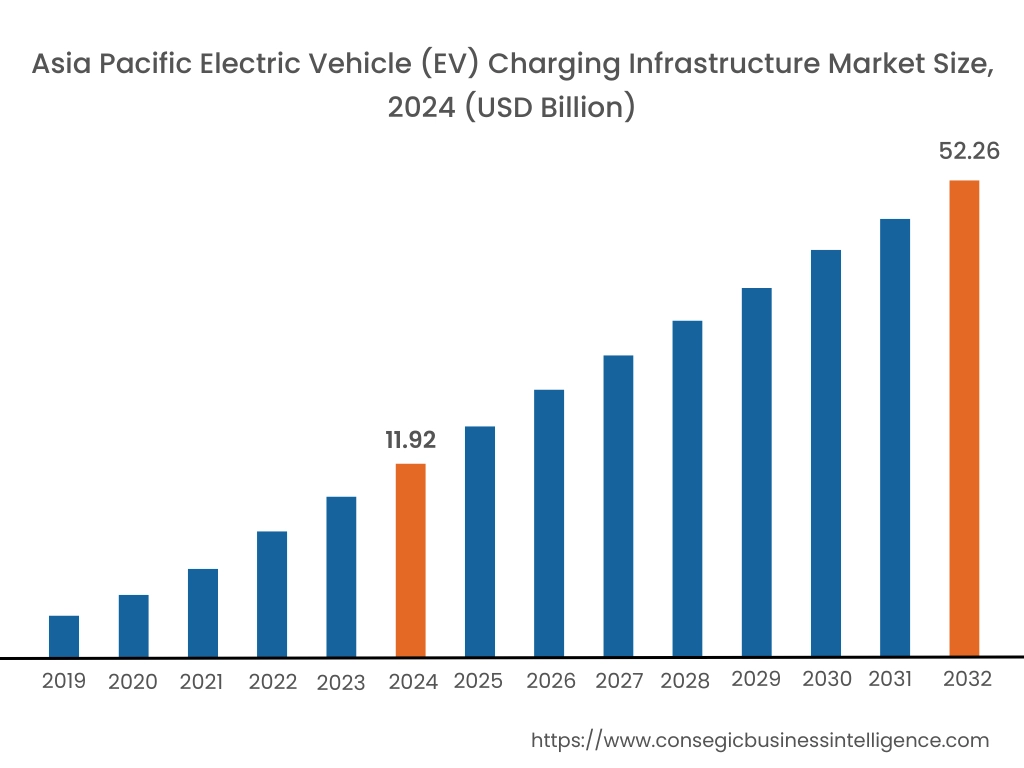
Asia Pacific region was valued at USD 11.92 Billion in 2024. Moreover, it is projected to grow by USD 14.12 Billion in 2025 and reach over USD 52.26 Billion by 2032. Out of this, China accounted for the maximum revenue share of 43.39%. The market is mainly driven by rising investment in the EV charging infrastructure development. Furthermore, factors including government support and urbanization are projected to drive the market progress in Asia Pacific region during the forecast period.
- For instance, according to IBEF, Hyundai Motor invested USD 2.45 billion in Tamil Nadu, India to install 100 charging stations for EVs and assemble EV battery packs.
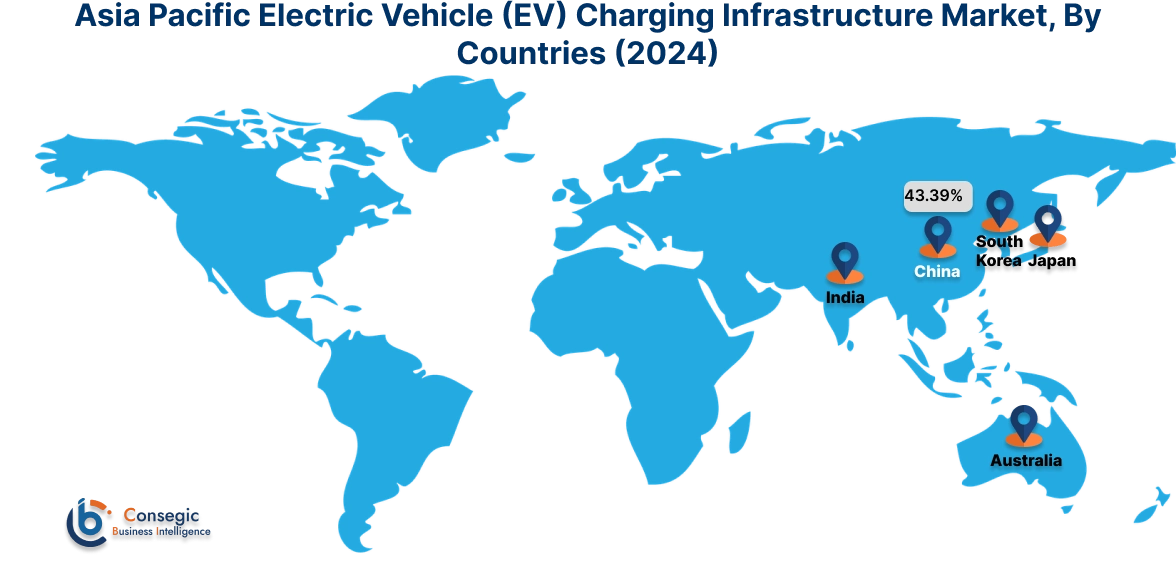
North America is estimated to reach over USD 29.09 Billion by 2032 from a value of USD 6.86 Billion in 2024 and is projected to grow by USD 8.10 Billion in 2025. The North American region's market is growing due to adoption of electric vehicles offers lucrative growth prospects for the market. Additionally, the growth of public and private charging stations is driving the market development.
- For instance, in March 2025, ChargePoint partnered with NY state energy research and development authority for deployment of EV fast charging station in New York.
The regional evaluation depicts that the government support and increasing investment is driving the market in Europe. Additionally, the key factor driving the market is adoption of fast charging solution and smart charging solutions in the Middle East and African region. Further, the increasing focus towards smart city initiative is paving the way for the progress of market in Latin America region.
Top Key Players and Market Share Insights:
The global electric vehicle (EV) charging infrastructure market is highly competitive with major players providing electric vehicle (EV) charging infrastructure to the national and international markets. Key players are adopting several strategies in research and development (R&D), product innovation, and end-user launches to hold a strong position in the electric vehicle (EV) charging infrastructure industry. Key players in the electric vehicle (EV) charging infrastructure market include-
- ABB (Switzerland)
- Star Charge (Singapore)
- Eaton (Ireland)
- DBT Technologies (USA)
- EVgo (USA)
- Efacec (Europe)
- ChargePoint (USA)
- EVBox (The Netherlands)
- GS Yuasa International (Japan)
- Plugless Power (USA)
Recent Industry Developments :
Expansion:
- In August 2024, Schaeffler expanded 5000 charging infrastructure which include 3000 infrastructure in European locality. Also, the company is focusing on providing sustainable solutions for EV charging.
Funding:
- In September 2024, Amazon invested USD 2.65 million for developing electric vehicle charging infrastructure which is planned to support over 5,500 EVs.
Electric Vehicle (EV) Charging Infrastructure Market Report Insights :
| Report Attributes | Report Details |
| Study Timeline | 2019-2032 |
| Market Size in 2032 | USD 116.38 Billion |
| CAGR (2025-2032) | 22.9% |
| By Charging |
|
| By Connector |
|
| By Voltage |
|
| By Operation |
|
| By Application |
|
| By Region |
|
| Key Players |
|
| North America | U.S. Canada Mexico |
| Europe | U.K. Germany France Spain Italy Russia Benelux Rest of Europe |
| APAC | China South Korea Japan India Australia ASEAN Rest of Asia-Pacific |
| Middle East and Africa | GCC Turkey South Africa Rest of MEA |
| LATAM | Brazil Argentina Chile Rest of LATAM |
| Report Coverage |
|
Key Questions Answered in the Report
How big is the electric vehicle (EV) charging infrastructure market? +
The electric vehicle (EV) charging infrastructure market size is estimated to reach over USD 116.38 billion by 2032 from a value of USD 27.09 billion in 2024 and is projected to grow by USD 32.03 billion in 2025, growing at a CAGR of 22.9% from 2025 to 2032.
What specific segmentation details are covered in the electric vehicle (EV) charging infrastructure report? +
The electric vehicle (EV) charging infrastructure report includes specific segmentation details for charging, connector, voltage, operation, application, and regions.
Which is the fastest segment anticipated to impact the market growth? +
In the electric vehicle (EV) charging infrastructure market, the CCS is the fastest-growing segment during the forecast period due to interoperability across the EV charging ecosystem.
Who are the major players in the electric vehicle (EV) charging infrastructure market? +
The key participants in the electric vehicle (EV) charging infrastructure market are ABB (Switzerland), Star Charge (Singapore), Eaton (Ireland), DBT Technologies (USA), EVgo (USA), Efacec (Europe), ChargePoint (USA), EVBox (The Netherlands), GS Yuasa International (Japan), Plugless Power (USA) and others.
What are the key trends in the electric vehicle (EV) charging infrastructure market? +
The electric vehicle (EV) charging infrastructure market is being shaped by several key trends including trend towards adoption of AI and automation to improve the efficiency and reliability of public charging stations as well as rising adoption of portable charging solutions and other are the key trends driving the market.
